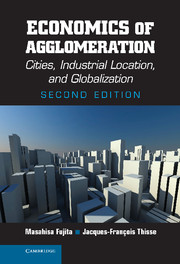Book contents
- Frontmatter
- Dedication
- Contents
- Acknowledgments
- Preface to the Second Edition
- 1 Agglomeration and Economic Theory
- Part I Fundamentals of Spatial Economics
- Part II The Structure of Metropolitan Areas
- Part III Factor Mobility and Industrial Location
- 8 Industrial Agglomeration under Monopolistic Competition
- 9 Market Size and Industrial Clusters
- Part IV Urban Systems, Regional Growth, and the Multinationalization of Firms
- References
- Author Index
- Subject Index
9 - Market Size and Industrial Clusters
Published online by Cambridge University Press: 05 August 2013
- Frontmatter
- Dedication
- Contents
- Acknowledgments
- Preface to the Second Edition
- 1 Agglomeration and Economic Theory
- Part I Fundamentals of Spatial Economics
- Part II The Structure of Metropolitan Areas
- Part III Factor Mobility and Industrial Location
- 8 Industrial Agglomeration under Monopolistic Competition
- 9 Market Size and Industrial Clusters
- Part IV Urban Systems, Regional Growth, and the Multinationalization of Firms
- References
- Author Index
- Subject Index
Summary
INTRODUCTION
Ever since Adam Smith, it is well known that market size matters for the division of labor, hence for economic development. In this chapter, we want to deal with a related, but different, idea, namely market size is one of the basic determinants of firms' choices of location. Both economists and geographers agree that a large market tends to increase the profitability of the firms established in it. First of all, in his location problem where a firm chooses the location minimizing the total transport costs it bears, Weber ([1909] 1927) showed that the market – or input source – that has a weight exceeding the weighted sum of the other markets and input sources is always the firm's optimal location. In the same vein, the gravity equation asserts that locations having a good access to large markets offer firms greater profit opportunities. The profitability of firms is further enhanced by increasing returns because the growth in their volume of production also generates a drop in their average production costs. As a result, it seems reasonable to expect larger markets to attract more firms than smaller markets. This idea agrees with market potential theory, as developed by the American geographer Harris (1954) according to which firms tend to locate where they have the best access to markets in which they can sell their product
- Type
- Chapter
- Information
- Economics of AgglomerationCities, Industrial Location, and Globalization, pp. 346 - 384Publisher: Cambridge University PressPrint publication year: 2013

